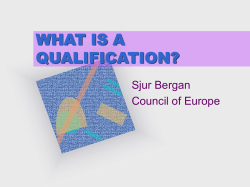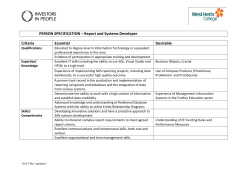
Yerevan Communiqué - ministerial conference 2015, Yerevan
YEREVAN COMMUNIQUÉ We, the Ministers, meeting in Yerevan on 14-15 May 2015, are proud to recognize that the vision which inspired our predecessors in Bologna has given rise to the European Higher Education Area (EHEA), where 47 countries with different political, cultural and academic traditions cooperate on the basis of open dialogue, shared goals and common commitments. Together we are engaged in a process of voluntary convergence and coordinated reform of our higher education systems. This is based on public responsibility for higher education, academic freedom, institutional autonomy, and commitment to integrity. It relies on strong public funding, and is implemented through a common degree structure, a shared understanding of principles and processes for quality assurance and recognition, and a number of common tools. Thanks to the Bologna reforms, progress has been made in enabling students and graduates to move within the EHEA with recognition of their qualifications and periods of study; study programmes provide graduates with the knowledge, skills and competences either to continue their studies or to enter the European labour market; institutions are becoming increasingly active in an international context; and academics cooperate in joint teaching and research programmes. The EHEA has opened a dialogue with other regions of the world and is considered a model of structured cooperation. Nonetheless, implementation of the structural reforms is uneven and the tools are sometimes used incorrectly or in bureaucratic and superficial ways. Continuing improvement of our higher education systems and greater involvement of academic communities are necessary to achieve the full potential of the EHEA. We are committed to completing the work, and recognize the need to give new impetus to our cooperation. Today, the EHEA faces serious challenges. It is confronted with a continuing economic and social crisis, dramatic levels of unemployment, increasing marginalization of young people, demographic changes, new migration patterns, and conflicts within and between countries, as well as extremism and radicalization. On the other hand, greater mobility of students and staff fosters mutual understanding, while rapid development of knowledge and technology, which impacts on societies and economies, plays an increasingly important role in the transformation of higher education and research. The EHEA has a key role to play in addressing these challenges and maximizing these opportunities through European collaboration and exchange, by pursuing common goals and in dialogue with partners around the globe. We must renew our original vision and consolidate the EHEA structure. A renewed vision: our priorities By 2020 we are determined to achieve an EHEA where our common goals are implemented in all member countries to ensure trust in each other’s higher education systems; where automatic recognition of qualifications has become a reality so that students and graduates can move easily throughout it; where higher education is contributing effectively to build inclusive societies, founded on democratic values and human rights; and where educational 1 opportunities provide the competences and skills required for European citizenship, innovation and employment. We will support and protect students and staff in exercising their right to academic freedom and ensure their representation as full partners in the governance of autonomous higher education institutions. We will support higher education institutions in enhancing their efforts to promote intercultural understanding, critical thinking, political and religious tolerance, gender equality, and democratic and civic values, in order to strengthen European and global citizenship and lay the foundations for inclusive societies. We will also strengthen the links between the EHEA and the European Research Area. In the coming years our collective ambition will be to pursue these equally important goals in the new context: • Enhancing the quality and relevance of learning and teaching is the main mission of the EHEA. We will encourage and support higher education institutions and staff in promoting pedagogical innovation in student-centred learning environments and in fully exploiting the potential benefits of digital technologies for learning and teaching. We will promote a stronger link between teaching, learning and research at all study levels, and provide incentives for institutions, teachers and students to intensify activities that develop creativity, innovation and entrepreneurship. Study programmes should enable students to develop the competences that can best satisfy personal aspirations and societal needs, through effective learning activities. These should be supported by transparent descriptions of learning outcomes and workload, flexible learning paths and appropriate teaching and assessment methods. It is essential to recognize and support quality teaching, and to provide opportunities for enhancing academics’ teaching competences. Moreover, we will actively involve students, as full members of the academic community, as well as other stakeholders, in curriculum design and in quality assurance. • Fostering the employability of graduates throughout their working lives in rapidly changing labour markets - characterized by technological developments, the emergence of new job profiles, and increasing opportunities for employment and selfemployment - is a major goal of the EHEA. We need to ensure that, at the end of each study cycle, graduates possess competences suitable for entry into the labour market which also enable them to develop the new competences they may need for their employability later in throughout their working lives. We will support higher education institutions in exploring diverse measures to reach these goals, e.g. by strengthening their dialogue with employers, implementing programmes with a good balance between theoretical and practical components, fostering the entrepreneurship and innovation skills of students and following graduates’ career developments. We will promote international mobility for study and placement as a powerful means to expand the range of competences and the work options for students. • Making our systems more inclusive is an essential aim for the EHEA as our populations become more and more diversified, also due to immigration and demographic changes. We undertake to widen participation in higher education and support institutions that provide relevant learning activities in appropriate contexts for different types of learners, including lifelong learning. We will improve permeability and articulation between different education sectors. We will enhance the social dimension of higher education, improve gender balance and widen opportunities for access and 2 completion, including international mobility, for students from disadvantaged backgrounds. We will provide mobility opportunities for students and staff from conflict areas, while working to make it possible for them to return home once conditions allow. We also wish to promote the mobility of teacher education students in view of the important role they will play in educating future generations of Europeans. • Implementing agreed structural reforms is a prerequisite for the consolidation of the EHEA and, in the long run, for its success. A common degree structure and credit system, common quality assurance standards and guidelines, cooperation for mobility and joint programmes and degrees are the foundations of the EHEA. We will develop more effective policies for the recognition of credits gained abroad, of qualifications for academic and professional purposes, and of prior learning. Full and coherent implementation of agreed reforms at the national level requires shared ownership and commitment by policy makers and academic communities and stronger involvement of stakeholders. Non-implementation in some countries undermines the functioning and credibility of the whole EHEA. We need more precise measurement of performance as a basis for reporting from member countries. Through policy dialogue and exchange of good practice, we will provide targeted support to member countries experiencing difficulties in implementing the agreed goals and enable those who wish to go further to do so. The governance and working methods of the EHEA must develop to meet these challenges. We ask the BFUG to review and simplify its governance and working methods, to involve higher education practitioners in its work programme, and to submit proposals for addressing the issue of non-implementation of key commitments in time for our next meeting. We gratefully accept the commitment of France to host our next meeting in 2018 and to provide the Secretariat of the EHEA from July 2015 through June 2018. Ministers welcome the application of Belarus to join the EHEA and in particular its commitment to implement reforms, 16 years after the launch of the Bologna Process, to make its higher education system and practice compatible with those of other EHEA countries. On that basis, Ministers welcome Belarus as a member of the EHEA and look forward to working with the national authorities and stakeholders to implement the reforms identified by the BFUG and included in the agreed road map attached to Belarusian accession. Ministers ask the BFUG to report on the implementation of the roadmap in time for the 2018 ministerial conference. Finally, we take note with approval of the reports by the working groups on Implementation, Structural reforms, Mobility and internationalization, and the Social dimension and lifelong learning, as well as by the Pathfinder group on automatic recognition. We adopt the measures included in the Appendix and take this opportunity to underline the importance of all members and consultative members participating fully in the work of the BFUG and contributing to the EHEA work programme. 3 Appendix I. Policy measures adopted ➢ the revised Standards and Guidelines for Quality Assurance in the European Higher Education Area (ESG) ➢ the European Approach for Quality Assurance of Joint Programmes ➢ the revised ECTS Users’ Guide, as an official EHEA document II. Commitments ➢ to include short cycle qualifications in the overarching framework of qualifications for the European Higher Education Area (QF-EHEA), based on the Dublin descriptors for short cycle qualifications and quality assured according to the ESG, so as to make provision for the recognition of short cycle qualifications in their own systems, also where these do not comprise such qualifications; ➢ to ensure that competence requirements for public employment allow for fair access to holders of first cycle degrees, and encourage employers to make appropriate use of all higher education qualifications, including those of the first cycle; ➢ to ensure, in collaboration with institutions, reliable and meaningful information on graduates’ career patterns and progression in the labour market, which should be provided to institutional leaders, potential students, their parents and society at large; ➢ to review national legislations with a view to fully complying with the Lisbon Recognition Convention, reporting to the Bologna Secretariat by the end of 2016, and asking the Convention Committee, in cooperation with the ENIC and NARIC Networks, to prepare an analysis of the reports by the end of 2017, taking due account of the monitoring of the Convention carried out by the Convention Committee; ➢ to remove obstacles to the recognition of prior learning for the purposes of providing access to higher education programmes and facilitating the award of qualifications on the basis of prior learning, as well as encouraging higher education institutions to improve their capacity to recognize prior learning; ➢ to review national qualifications frameworks, with a view to ensuring that learning paths within the framework provide adequately for the recognition of prior learning; ➢ to establish a group of volunteering countries and organizations with a view to facilitating professional recognition; ➢ to promote staff mobility taking into account the guidelines from the Working group on mobility and internationalization; ➢ to promote the portability of grants and loans taking into account the guidelines from the Working group on mobility and internationalization; ➢ to make our higher education more socially inclusive by implementing the EHEA social dimension strategy; 4 ➢ to ensure that qualifications from other EHEA countries are automatically recognized at the same level as relevant domestic qualifications; ➢ to enable our higher education institutions to use a suitable EQAR registered agency for their external quality assurance process, respecting the national arrangements for the decision making on QA outcomes. 5
© Copyright 2025










